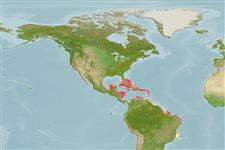>
Blenniiformes (Blennies) >
Chaenopsidae (Pike-, tube- and flagblennies)
Etymology: Stathmonotus: Greek, stathmos, -ou = a big room + Greek, noton = back (Ref. 45335).
More on authors: Evermann & Marsh.
Environment: milieu / climate zone / depth range / distribution range
البيئة
بحري مرتبطة بالشعاب; نطاق العمق ? - 10 m (Ref. 13628). Subtropical
Eastern Caribbean Sea from Los Roques Venezuela, Lesser Antilles to Puerto Rico.
الحجم / وزن / العمر
Maturity: Lm ? range ? - ? cm
Max length : 4.0 cm TL ذكر/ مختلط الجنس; (Ref. 7251)
وصف مختصر
الوصف الخارجي | قياسات المظهر الخارجي
الأشواك الظهرية (المجموع): 0; الأشعة الظهرية الناعمة (المجموع): 43-44; شوكة شرجية 2; أشعه شرجية لينه: 24 - 25. Stathmonotus stahli differs from Stathmonotus tekla in the following: segmented caudal rays 11-13, modally 12 (vs. 10-12, modally 11); dorsal-fin spines 41-45, modally 43 (vs. 39-44, modally 42); and precaudal vertebrae 17-19, modally 18 (vs. 16-19, modally 17) (Ref. 82814).
Lives in rubble areas covered by mats of algae and sponges or in beds of finger coral. Generally found in less than 10 m depth (Ref. 13628).
Life cycle and mating behavior
النضج | التكاثر | وضع البيض | بيض | الخصوبة | Larvae
Robins, C.R. and G.C. Ray, 1986. A field guide to Atlantic coast fishes of North America. Houghton Mifflin Company, Boston, U.S.A. 354 p. (Ref. 7251)
IUCN Red List Status (Ref. 130435)
استخدامات بشرية
مزيد من المعلومات
الأسماء الشائعةمرادفاتالأيضمفتريساتعلم السميات البيئيةالتكاثرالنضجوضع البيضتجمعات وضع البيضالخصوبةبيضتطور البيضة
العمر/ الحجمنموالطول-الوزنالطول-الطولالطول- التردداتقياسات المظهر الخارجيالوصف الخارجيLarvaeحركة انتقال اليرقاتتوظيفالوفرةBRUVS
مراجعالأستزراع المائيملف الأستزراع المائيسلالاتجينيElectrophoresesالتوريثالأمراضمعالجةNutrientsMass conversion
المتعاونينصورStamps, Coins Misc.اصواتالتسمم باكل السمكسرعةنوع السباحةمنطقة الخياشيمعظمة الأذندماغرؤية
أدوات
تقارير خاصة
Download XML
مصادر علي الأنترنت
Estimates based on models
Preferred temperature (Ref.
123201): 26.4 - 28.2, mean 27.5 °C (based on 548 cells).
Phylogenetic diversity index (Ref.
82804): PD
50 = 0.5078 [Uniqueness, from 0.5 = low to 2.0 = high].
Bayesian length-weight: a=0.00457 (0.00183 - 0.01143), b=3.08 (2.86 - 3.30), in cm total length, based on LWR estimates for this (Sub)family-body shape (Ref.
93245).
مستوى غذائي (Ref.
69278): 3.3 ±0.5 se; based on size and trophs of closest relatives
Fishing Vulnerability (Ref.
59153): Low vulnerability (10 of 100).
Nutrients (Ref.
124155): Calcium = 146 [51, 344] mg/100g; Iron = 0.956 [0.470, 2.009] mg/100g; Protein = 18.6 [17.3, 19.8] %; Omega3 = 0.156 [0.068, 0.346] g/100g; Selenium = 6.89 [2.44, 19.97] μg/100g; VitaminA = 284 [76, 1,156] μg/100g; Zinc = 1.69 [0.94, 2.90] mg/100g (wet weight);
